Legal Methods and Skills: A Detailed Case Note on Jones v Bartlett
VerifiedAdded on 2023/06/04
|12
|2905
|296
Case Study
AI Summary
This case note provides an in-depth analysis of the High Court of Australia's decision in Jones v Bartlett (2000) 205 CLR 166, focusing on legal methods and skills. It identifies the ratio decidendi, material facts, reasoning, and outcome of the case, along with important obiter dicta. The case revolves around an appellant who suffered injuries after walking through a glass door in a rented house. The analysis covers the appellant's claims under the Residential Tenancies Act 1987 (WA) and the Property Law Act 1969 (WA), as well as the application of the Occupier's Liability Act. The reasoning of the Commissioner and the Full Court are compared, highlighting differing interpretations of duty of care and negligence. The case note also includes a critique of the decision, evaluating its merits and implications for landlords' duties under Australian Common Law. Ultimately, the court dismissed the appeal, finding no failure on the part of the respondents to take reasonable care.
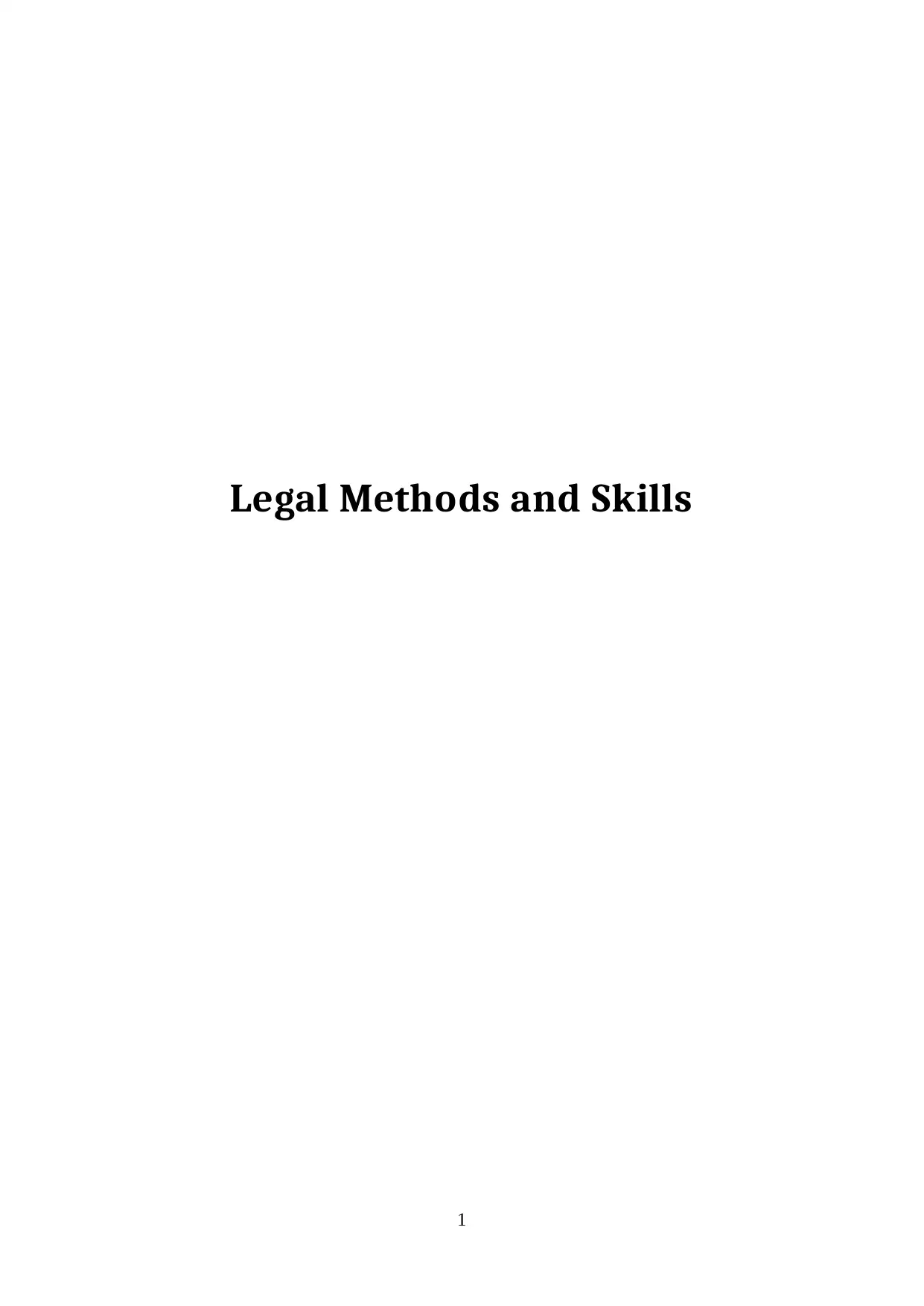
Legal Methods and Skills
1
1
Paraphrase This Document
Need a fresh take? Get an instant paraphrase of this document with our AI Paraphraser
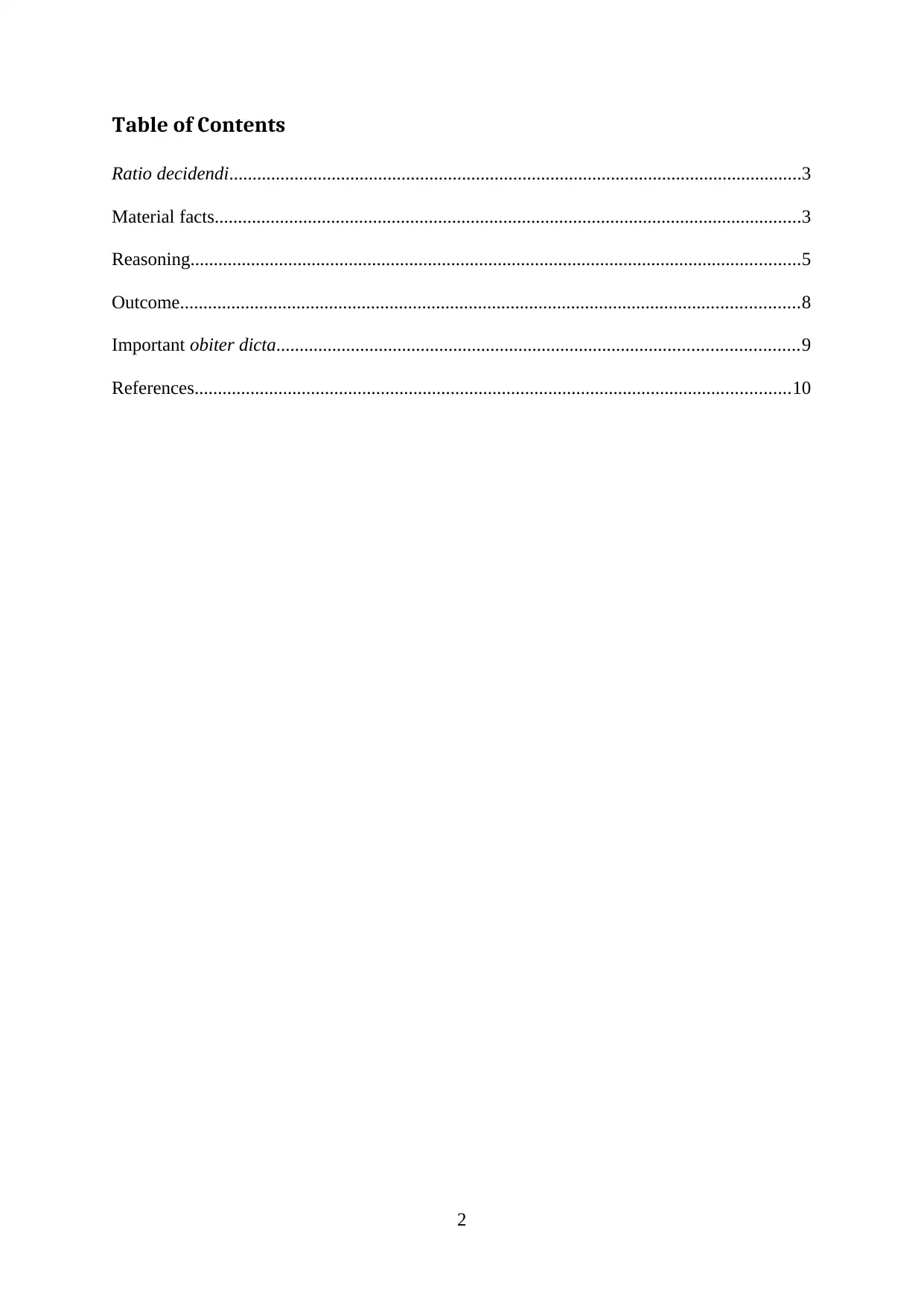
Table of Contents
Ratio decidendi...........................................................................................................................3
Material facts..............................................................................................................................3
Reasoning...................................................................................................................................5
Outcome.....................................................................................................................................8
Important obiter dicta................................................................................................................9
References................................................................................................................................10
2
Ratio decidendi...........................................................................................................................3
Material facts..............................................................................................................................3
Reasoning...................................................................................................................................5
Outcome.....................................................................................................................................8
Important obiter dicta................................................................................................................9
References................................................................................................................................10
2
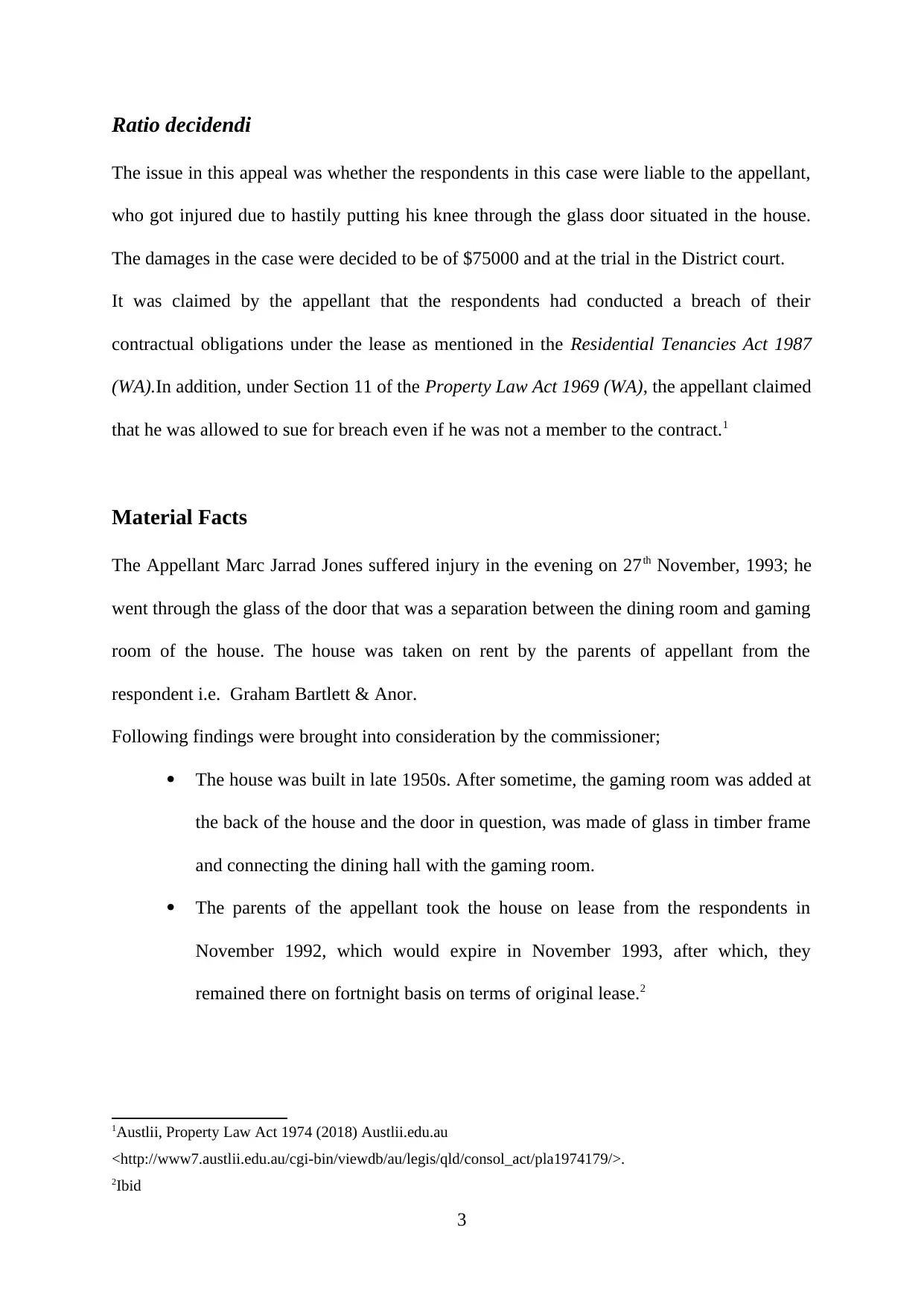
Ratio decidendi
The issue in this appeal was whether the respondents in this case were liable to the appellant,
who got injured due to hastily putting his knee through the glass door situated in the house.
The damages in the case were decided to be of $75000 and at the trial in the District court.
It was claimed by the appellant that the respondents had conducted a breach of their
contractual obligations under the lease as mentioned in the Residential Tenancies Act 1987
(WA).In addition, under Section 11 of the Property Law Act 1969 (WA), the appellant claimed
that he was allowed to sue for breach even if he was not a member to the contract.1
Material Facts
The Appellant Marc Jarrad Jones suffered injury in the evening on 27th November, 1993; he
went through the glass of the door that was a separation between the dining room and gaming
room of the house. The house was taken on rent by the parents of appellant from the
respondent i.e. Graham Bartlett & Anor.
Following findings were brought into consideration by the commissioner;
The house was built in late 1950s. After sometime, the gaming room was added at
the back of the house and the door in question, was made of glass in timber frame
and connecting the dining hall with the gaming room.
The parents of the appellant took the house on lease from the respondents in
November 1992, which would expire in November 1993, after which, they
remained there on fortnight basis on terms of original lease.2
1Austlii, Property Law Act 1974 (2018) Austlii.edu.au
<http://www7.austlii.edu.au/cgi-bin/viewdb/au/legis/qld/consol_act/pla1974179/>.
2Ibid
3
The issue in this appeal was whether the respondents in this case were liable to the appellant,
who got injured due to hastily putting his knee through the glass door situated in the house.
The damages in the case were decided to be of $75000 and at the trial in the District court.
It was claimed by the appellant that the respondents had conducted a breach of their
contractual obligations under the lease as mentioned in the Residential Tenancies Act 1987
(WA).In addition, under Section 11 of the Property Law Act 1969 (WA), the appellant claimed
that he was allowed to sue for breach even if he was not a member to the contract.1
Material Facts
The Appellant Marc Jarrad Jones suffered injury in the evening on 27th November, 1993; he
went through the glass of the door that was a separation between the dining room and gaming
room of the house. The house was taken on rent by the parents of appellant from the
respondent i.e. Graham Bartlett & Anor.
Following findings were brought into consideration by the commissioner;
The house was built in late 1950s. After sometime, the gaming room was added at
the back of the house and the door in question, was made of glass in timber frame
and connecting the dining hall with the gaming room.
The parents of the appellant took the house on lease from the respondents in
November 1992, which would expire in November 1993, after which, they
remained there on fortnight basis on terms of original lease.2
1Austlii, Property Law Act 1974 (2018) Austlii.edu.au
<http://www7.austlii.edu.au/cgi-bin/viewdb/au/legis/qld/consol_act/pla1974179/>.
2Ibid
3
⊘ This is a preview!⊘
Do you want full access?
Subscribe today to unlock all pages.

Trusted by 1+ million students worldwide
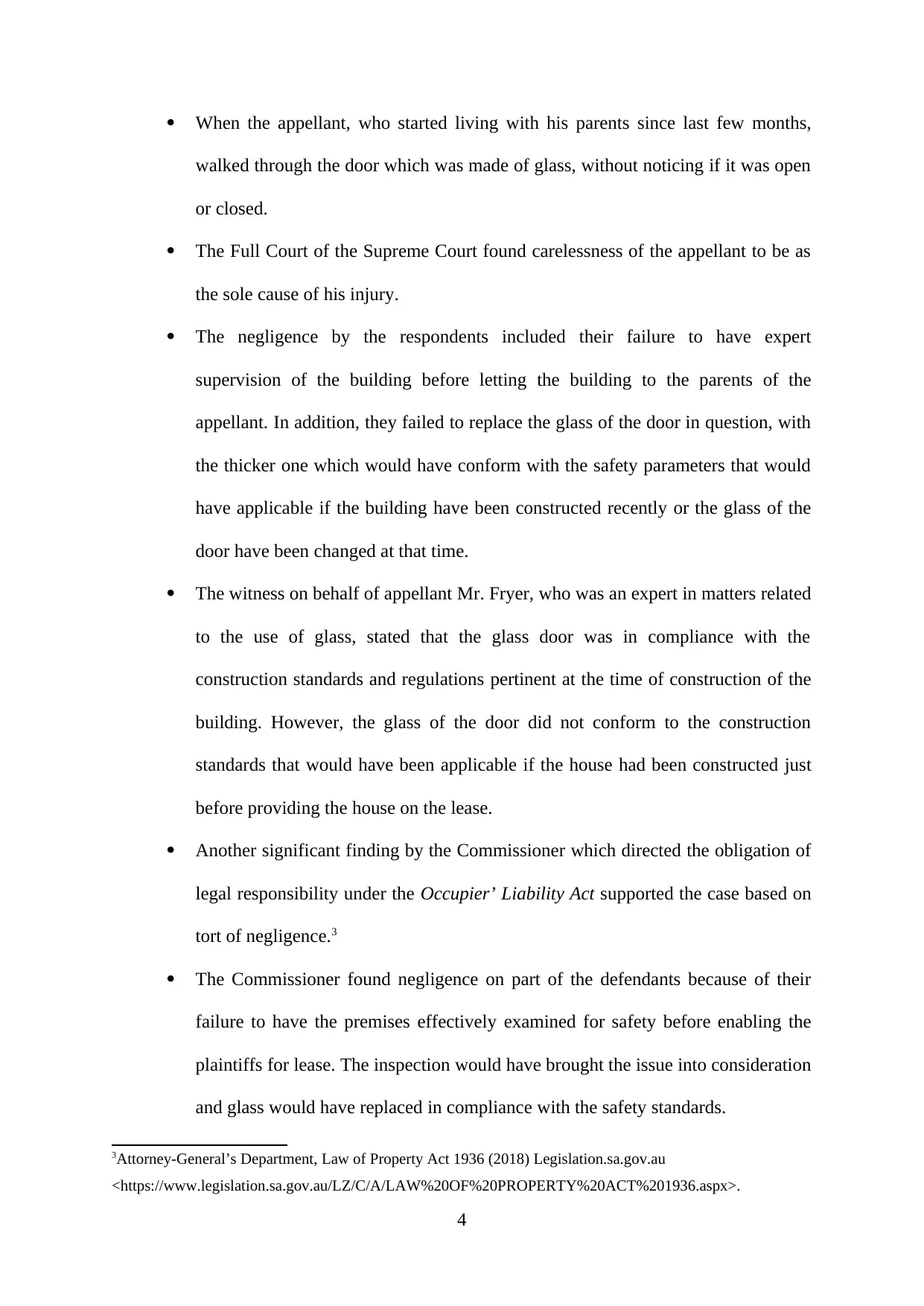
When the appellant, who started living with his parents since last few months,
walked through the door which was made of glass, without noticing if it was open
or closed.
The Full Court of the Supreme Court found carelessness of the appellant to be as
the sole cause of his injury.
The negligence by the respondents included their failure to have expert
supervision of the building before letting the building to the parents of the
appellant. In addition, they failed to replace the glass of the door in question, with
the thicker one which would have conform with the safety parameters that would
have applicable if the building have been constructed recently or the glass of the
door have been changed at that time.
The witness on behalf of appellant Mr. Fryer, who was an expert in matters related
to the use of glass, stated that the glass door was in compliance with the
construction standards and regulations pertinent at the time of construction of the
building. However, the glass of the door did not conform to the construction
standards that would have been applicable if the house had been constructed just
before providing the house on the lease.
Another significant finding by the Commissioner which directed the obligation of
legal responsibility under the Occupier’ Liability Act supported the case based on
tort of negligence.3
The Commissioner found negligence on part of the defendants because of their
failure to have the premises effectively examined for safety before enabling the
plaintiffs for lease. The inspection would have brought the issue into consideration
and glass would have replaced in compliance with the safety standards.
3Attorney-General’s Department, Law of Property Act 1936 (2018) Legislation.sa.gov.au
<https://www.legislation.sa.gov.au/LZ/C/A/LAW%20OF%20PROPERTY%20ACT%201936.aspx>.
4
walked through the door which was made of glass, without noticing if it was open
or closed.
The Full Court of the Supreme Court found carelessness of the appellant to be as
the sole cause of his injury.
The negligence by the respondents included their failure to have expert
supervision of the building before letting the building to the parents of the
appellant. In addition, they failed to replace the glass of the door in question, with
the thicker one which would have conform with the safety parameters that would
have applicable if the building have been constructed recently or the glass of the
door have been changed at that time.
The witness on behalf of appellant Mr. Fryer, who was an expert in matters related
to the use of glass, stated that the glass door was in compliance with the
construction standards and regulations pertinent at the time of construction of the
building. However, the glass of the door did not conform to the construction
standards that would have been applicable if the house had been constructed just
before providing the house on the lease.
Another significant finding by the Commissioner which directed the obligation of
legal responsibility under the Occupier’ Liability Act supported the case based on
tort of negligence.3
The Commissioner found negligence on part of the defendants because of their
failure to have the premises effectively examined for safety before enabling the
plaintiffs for lease. The inspection would have brought the issue into consideration
and glass would have replaced in compliance with the safety standards.
3Attorney-General’s Department, Law of Property Act 1936 (2018) Legislation.sa.gov.au
<https://www.legislation.sa.gov.au/LZ/C/A/LAW%20OF%20PROPERTY%20ACT%201936.aspx>.
4
Paraphrase This Document
Need a fresh take? Get an instant paraphrase of this document with our AI Paraphraser
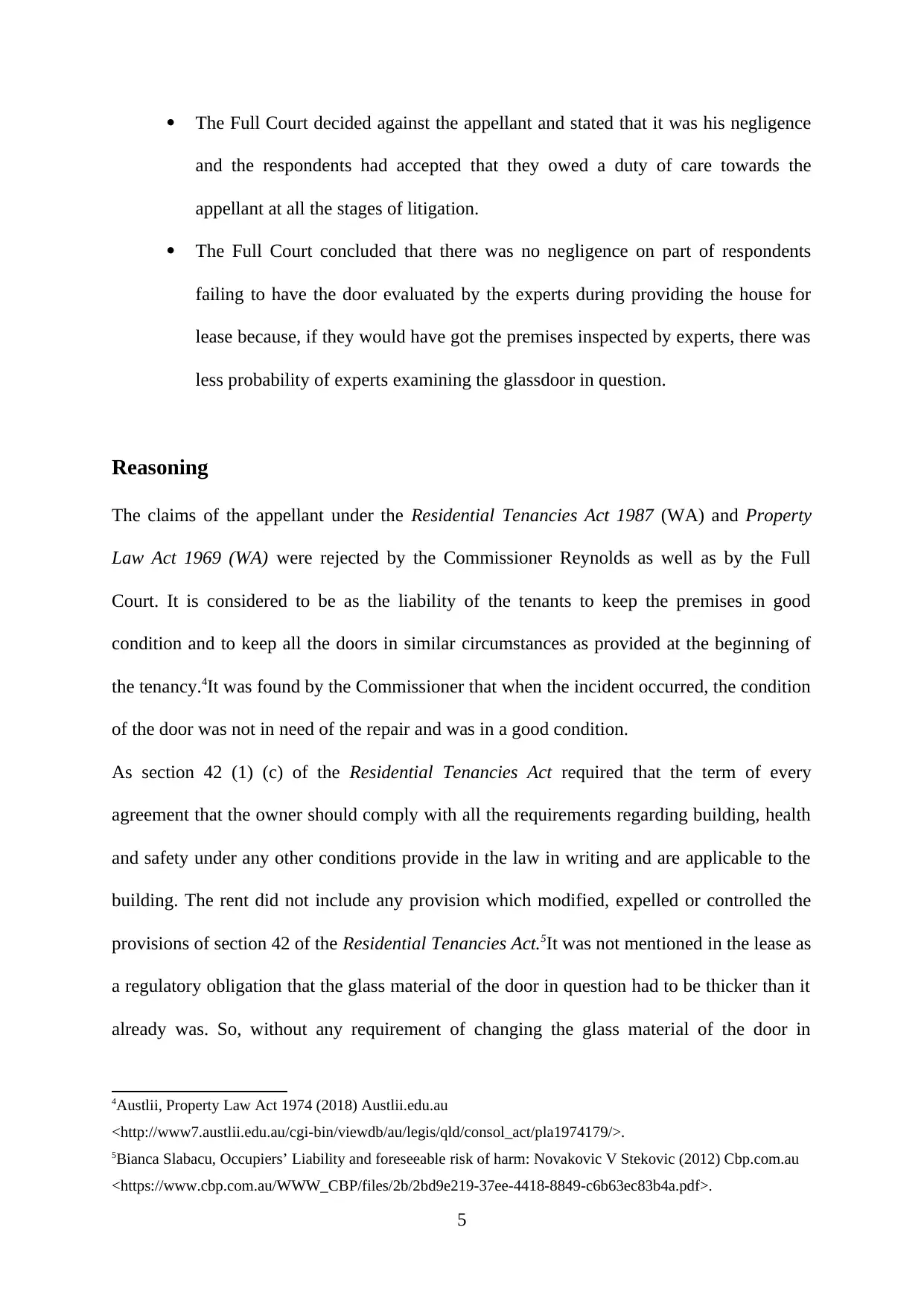
The Full Court decided against the appellant and stated that it was his negligence
and the respondents had accepted that they owed a duty of care towards the
appellant at all the stages of litigation.
The Full Court concluded that there was no negligence on part of respondents
failing to have the door evaluated by the experts during providing the house for
lease because, if they would have got the premises inspected by experts, there was
less probability of experts examining the glassdoor in question.
Reasoning
The claims of the appellant under the Residential Tenancies Act 1987 (WA) and Property
Law Act 1969 (WA) were rejected by the Commissioner Reynolds as well as by the Full
Court. It is considered to be as the liability of the tenants to keep the premises in good
condition and to keep all the doors in similar circumstances as provided at the beginning of
the tenancy.4It was found by the Commissioner that when the incident occurred, the condition
of the door was not in need of the repair and was in a good condition.
As section 42 (1) (c) of the Residential Tenancies Act required that the term of every
agreement that the owner should comply with all the requirements regarding building, health
and safety under any other conditions provide in the law in writing and are applicable to the
building. The rent did not include any provision which modified, expelled or controlled the
provisions of section 42 of the Residential Tenancies Act.5It was not mentioned in the lease as
a regulatory obligation that the glass material of the door in question had to be thicker than it
already was. So, without any requirement of changing the glass material of the door in
4Austlii, Property Law Act 1974 (2018) Austlii.edu.au
<http://www7.austlii.edu.au/cgi-bin/viewdb/au/legis/qld/consol_act/pla1974179/>.
5Bianca Slabacu, Occupiers’ Liability and foreseeable risk of harm: Novakovic V Stekovic (2012) Cbp.com.au
<https://www.cbp.com.au/WWW_CBP/files/2b/2bd9e219-37ee-4418-8849-c6b63ec83b4a.pdf>.
5
and the respondents had accepted that they owed a duty of care towards the
appellant at all the stages of litigation.
The Full Court concluded that there was no negligence on part of respondents
failing to have the door evaluated by the experts during providing the house for
lease because, if they would have got the premises inspected by experts, there was
less probability of experts examining the glassdoor in question.
Reasoning
The claims of the appellant under the Residential Tenancies Act 1987 (WA) and Property
Law Act 1969 (WA) were rejected by the Commissioner Reynolds as well as by the Full
Court. It is considered to be as the liability of the tenants to keep the premises in good
condition and to keep all the doors in similar circumstances as provided at the beginning of
the tenancy.4It was found by the Commissioner that when the incident occurred, the condition
of the door was not in need of the repair and was in a good condition.
As section 42 (1) (c) of the Residential Tenancies Act required that the term of every
agreement that the owner should comply with all the requirements regarding building, health
and safety under any other conditions provide in the law in writing and are applicable to the
building. The rent did not include any provision which modified, expelled or controlled the
provisions of section 42 of the Residential Tenancies Act.5It was not mentioned in the lease as
a regulatory obligation that the glass material of the door in question had to be thicker than it
already was. So, without any requirement of changing the glass material of the door in
4Austlii, Property Law Act 1974 (2018) Austlii.edu.au
<http://www7.austlii.edu.au/cgi-bin/viewdb/au/legis/qld/consol_act/pla1974179/>.
5Bianca Slabacu, Occupiers’ Liability and foreseeable risk of harm: Novakovic V Stekovic (2012) Cbp.com.au
<https://www.cbp.com.au/WWW_CBP/files/2b/2bd9e219-37ee-4418-8849-c6b63ec83b4a.pdf>.
5
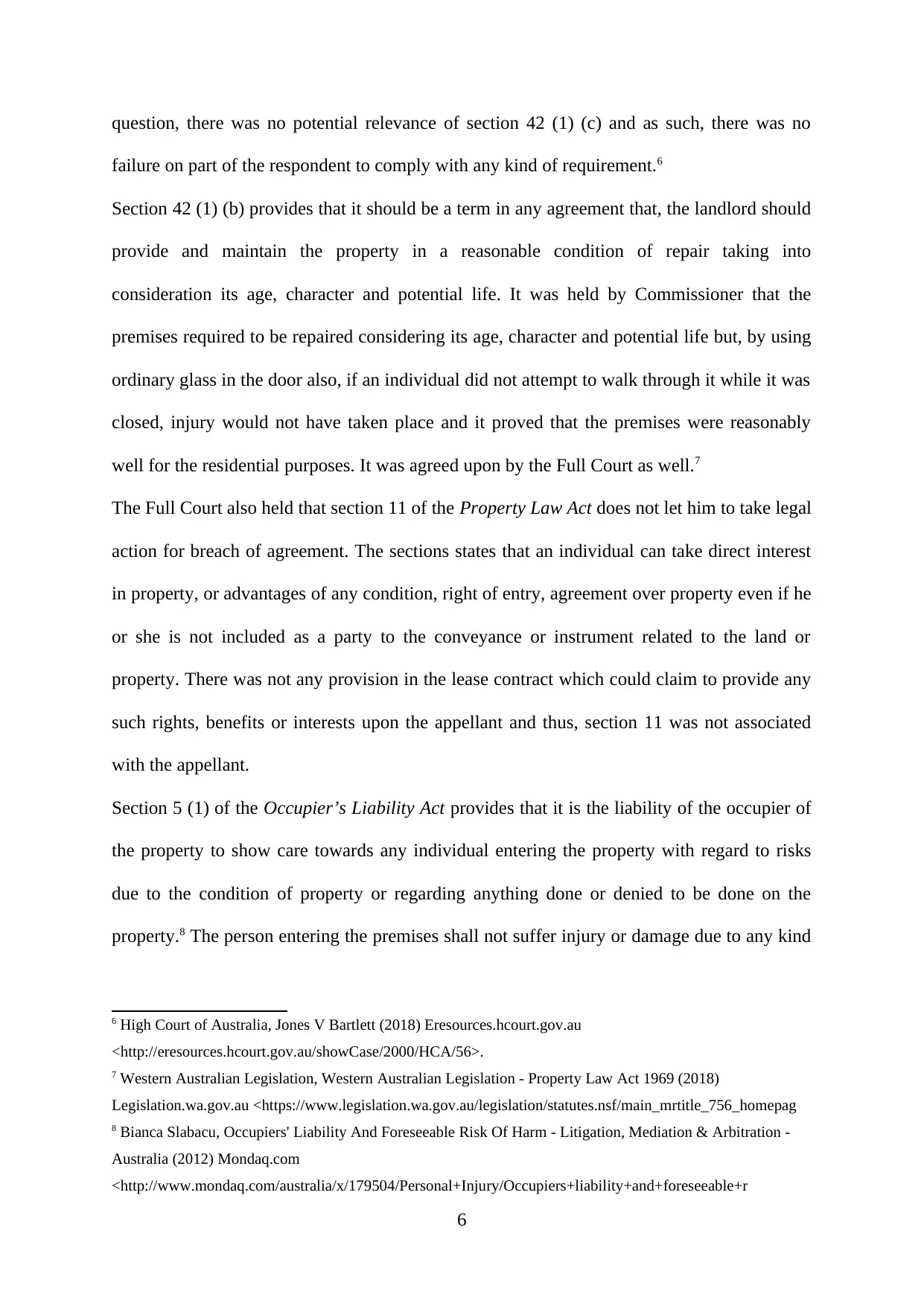
question, there was no potential relevance of section 42 (1) (c) and as such, there was no
failure on part of the respondent to comply with any kind of requirement.6
Section 42 (1) (b) provides that it should be a term in any agreement that, the landlord should
provide and maintain the property in a reasonable condition of repair taking into
consideration its age, character and potential life. It was held by Commissioner that the
premises required to be repaired considering its age, character and potential life but, by using
ordinary glass in the door also, if an individual did not attempt to walk through it while it was
closed, injury would not have taken place and it proved that the premises were reasonably
well for the residential purposes. It was agreed upon by the Full Court as well.7
The Full Court also held that section 11 of the Property Law Act does not let him to take legal
action for breach of agreement. The sections states that an individual can take direct interest
in property, or advantages of any condition, right of entry, agreement over property even if he
or she is not included as a party to the conveyance or instrument related to the land or
property. There was not any provision in the lease contract which could claim to provide any
such rights, benefits or interests upon the appellant and thus, section 11 was not associated
with the appellant.
Section 5 (1) of the Occupier’s Liability Act provides that it is the liability of the occupier of
the property to show care towards any individual entering the property with regard to risks
due to the condition of property or regarding anything done or denied to be done on the
property.8 The person entering the premises shall not suffer injury or damage due to any kind
6 High Court of Australia, Jones V Bartlett (2018) Eresources.hcourt.gov.au
<http://eresources.hcourt.gov.au/showCase/2000/HCA/56>.
7 Western Australian Legislation, Western Australian Legislation - Property Law Act 1969 (2018)
Legislation.wa.gov.au <https://www.legislation.wa.gov.au/legislation/statutes.nsf/main_mrtitle_756_homepag
8 Bianca Slabacu, Occupiers' Liability And Foreseeable Risk Of Harm - Litigation, Mediation & Arbitration -
Australia (2012) Mondaq.com
<http://www.mondaq.com/australia/x/179504/Personal+Injury/Occupiers+liability+and+foreseeable+r
6
failure on part of the respondent to comply with any kind of requirement.6
Section 42 (1) (b) provides that it should be a term in any agreement that, the landlord should
provide and maintain the property in a reasonable condition of repair taking into
consideration its age, character and potential life. It was held by Commissioner that the
premises required to be repaired considering its age, character and potential life but, by using
ordinary glass in the door also, if an individual did not attempt to walk through it while it was
closed, injury would not have taken place and it proved that the premises were reasonably
well for the residential purposes. It was agreed upon by the Full Court as well.7
The Full Court also held that section 11 of the Property Law Act does not let him to take legal
action for breach of agreement. The sections states that an individual can take direct interest
in property, or advantages of any condition, right of entry, agreement over property even if he
or she is not included as a party to the conveyance or instrument related to the land or
property. There was not any provision in the lease contract which could claim to provide any
such rights, benefits or interests upon the appellant and thus, section 11 was not associated
with the appellant.
Section 5 (1) of the Occupier’s Liability Act provides that it is the liability of the occupier of
the property to show care towards any individual entering the property with regard to risks
due to the condition of property or regarding anything done or denied to be done on the
property.8 The person entering the premises shall not suffer injury or damage due to any kind
6 High Court of Australia, Jones V Bartlett (2018) Eresources.hcourt.gov.au
<http://eresources.hcourt.gov.au/showCase/2000/HCA/56>.
7 Western Australian Legislation, Western Australian Legislation - Property Law Act 1969 (2018)
Legislation.wa.gov.au <https://www.legislation.wa.gov.au/legislation/statutes.nsf/main_mrtitle_756_homepag
8 Bianca Slabacu, Occupiers' Liability And Foreseeable Risk Of Harm - Litigation, Mediation & Arbitration -
Australia (2012) Mondaq.com
<http://www.mondaq.com/australia/x/179504/Personal+Injury/Occupiers+liability+and+foreseeable+r
6
⊘ This is a preview!⊘
Do you want full access?
Subscribe today to unlock all pages.

Trusted by 1+ million students worldwide
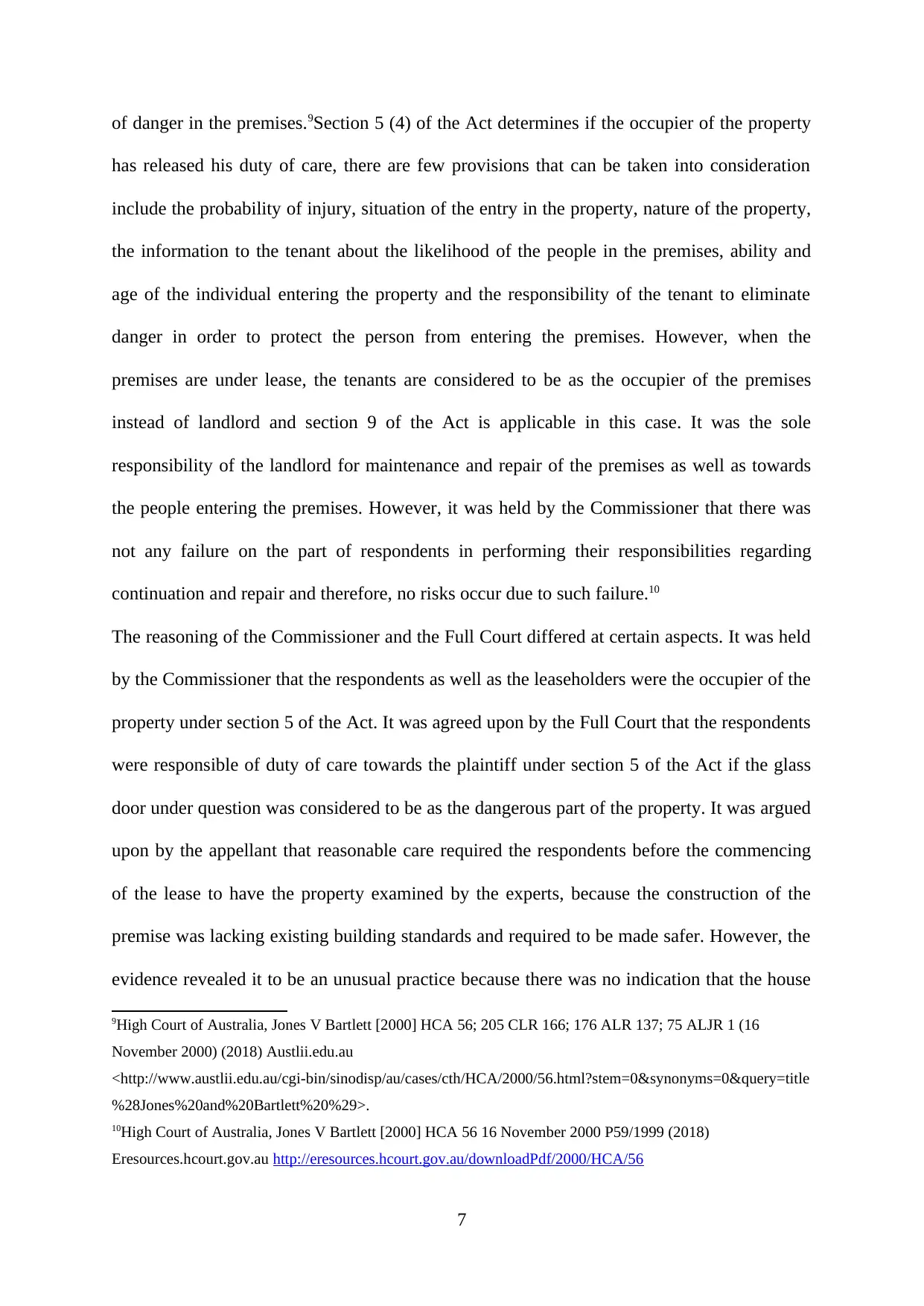
of danger in the premises.9Section 5 (4) of the Act determines if the occupier of the property
has released his duty of care, there are few provisions that can be taken into consideration
include the probability of injury, situation of the entry in the property, nature of the property,
the information to the tenant about the likelihood of the people in the premises, ability and
age of the individual entering the property and the responsibility of the tenant to eliminate
danger in order to protect the person from entering the premises. However, when the
premises are under lease, the tenants are considered to be as the occupier of the premises
instead of landlord and section 9 of the Act is applicable in this case. It was the sole
responsibility of the landlord for maintenance and repair of the premises as well as towards
the people entering the premises. However, it was held by the Commissioner that there was
not any failure on the part of respondents in performing their responsibilities regarding
continuation and repair and therefore, no risks occur due to such failure.10
The reasoning of the Commissioner and the Full Court differed at certain aspects. It was held
by the Commissioner that the respondents as well as the leaseholders were the occupier of the
property under section 5 of the Act. It was agreed upon by the Full Court that the respondents
were responsible of duty of care towards the plaintiff under section 5 of the Act if the glass
door under question was considered to be as the dangerous part of the property. It was argued
upon by the appellant that reasonable care required the respondents before the commencing
of the lease to have the property examined by the experts, because the construction of the
premise was lacking existing building standards and required to be made safer. However, the
evidence revealed it to be an unusual practice because there was no indication that the house
9High Court of Australia, Jones V Bartlett [2000] HCA 56; 205 CLR 166; 176 ALR 137; 75 ALJR 1 (16
November 2000) (2018) Austlii.edu.au
<http://www.austlii.edu.au/cgi-bin/sinodisp/au/cases/cth/HCA/2000/56.html?stem=0&synonyms=0&query=title
%28Jones%20and%20Bartlett%20%29>.
10High Court of Australia, Jones V Bartlett [2000] HCA 56 16 November 2000 P59/1999 (2018)
Eresources.hcourt.gov.au http://eresources.hcourt.gov.au/downloadPdf/2000/HCA/56
7
has released his duty of care, there are few provisions that can be taken into consideration
include the probability of injury, situation of the entry in the property, nature of the property,
the information to the tenant about the likelihood of the people in the premises, ability and
age of the individual entering the property and the responsibility of the tenant to eliminate
danger in order to protect the person from entering the premises. However, when the
premises are under lease, the tenants are considered to be as the occupier of the premises
instead of landlord and section 9 of the Act is applicable in this case. It was the sole
responsibility of the landlord for maintenance and repair of the premises as well as towards
the people entering the premises. However, it was held by the Commissioner that there was
not any failure on the part of respondents in performing their responsibilities regarding
continuation and repair and therefore, no risks occur due to such failure.10
The reasoning of the Commissioner and the Full Court differed at certain aspects. It was held
by the Commissioner that the respondents as well as the leaseholders were the occupier of the
property under section 5 of the Act. It was agreed upon by the Full Court that the respondents
were responsible of duty of care towards the plaintiff under section 5 of the Act if the glass
door under question was considered to be as the dangerous part of the property. It was argued
upon by the appellant that reasonable care required the respondents before the commencing
of the lease to have the property examined by the experts, because the construction of the
premise was lacking existing building standards and required to be made safer. However, the
evidence revealed it to be an unusual practice because there was no indication that the house
9High Court of Australia, Jones V Bartlett [2000] HCA 56; 205 CLR 166; 176 ALR 137; 75 ALJR 1 (16
November 2000) (2018) Austlii.edu.au
<http://www.austlii.edu.au/cgi-bin/sinodisp/au/cases/cth/HCA/2000/56.html?stem=0&synonyms=0&query=title
%28Jones%20and%20Bartlett%20%29>.
10High Court of Australia, Jones V Bartlett [2000] HCA 56 16 November 2000 P59/1999 (2018)
Eresources.hcourt.gov.au http://eresources.hcourt.gov.au/downloadPdf/2000/HCA/56
7
Paraphrase This Document
Need a fresh take? Get an instant paraphrase of this document with our AI Paraphraser
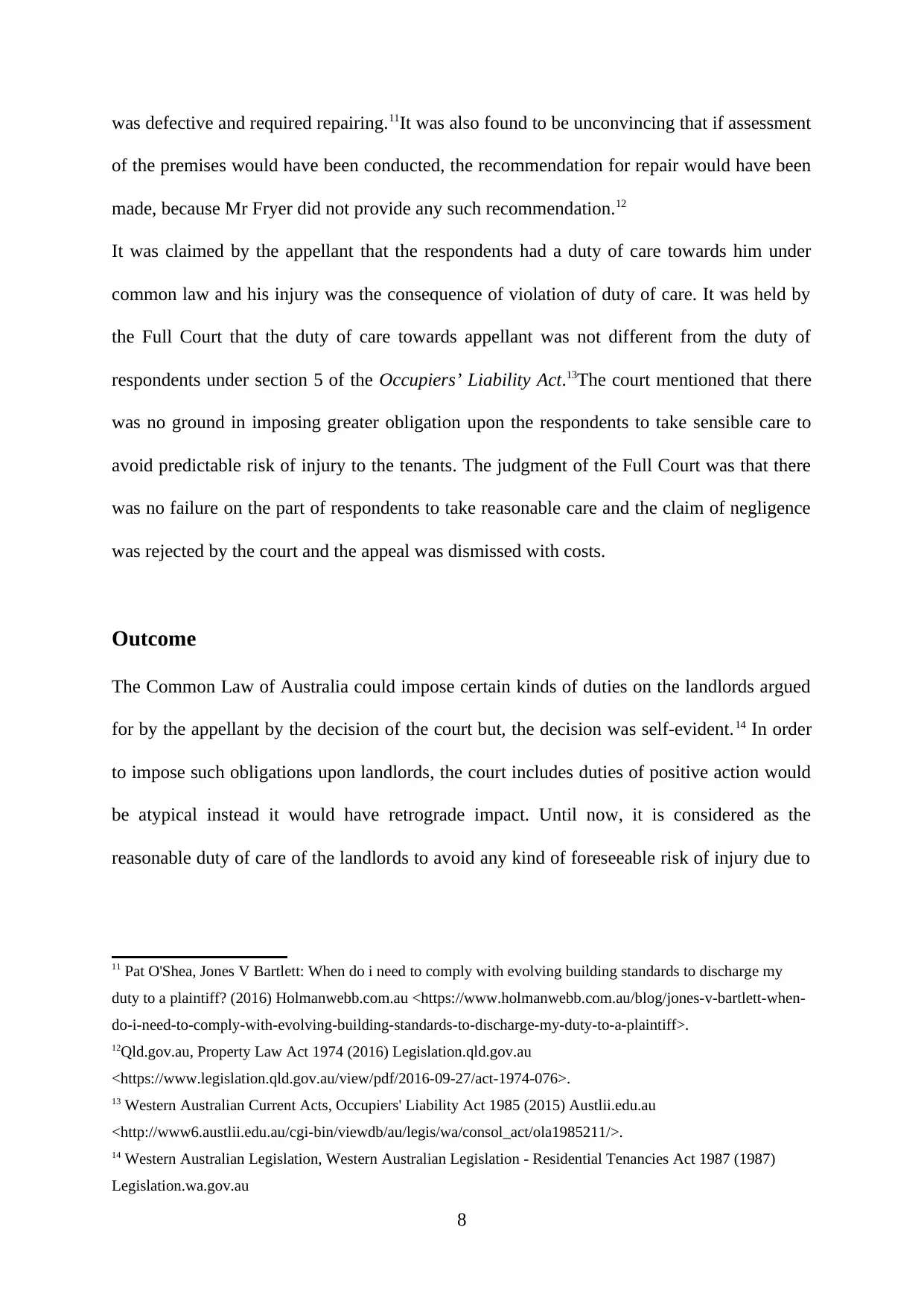
was defective and required repairing.11It was also found to be unconvincing that if assessment
of the premises would have been conducted, the recommendation for repair would have been
made, because Mr Fryer did not provide any such recommendation.12
It was claimed by the appellant that the respondents had a duty of care towards him under
common law and his injury was the consequence of violation of duty of care. It was held by
the Full Court that the duty of care towards appellant was not different from the duty of
respondents under section 5 of the Occupiers’ Liability Act.13The court mentioned that there
was no ground in imposing greater obligation upon the respondents to take sensible care to
avoid predictable risk of injury to the tenants. The judgment of the Full Court was that there
was no failure on the part of respondents to take reasonable care and the claim of negligence
was rejected by the court and the appeal was dismissed with costs.
Outcome
The Common Law of Australia could impose certain kinds of duties on the landlords argued
for by the appellant by the decision of the court but, the decision was self-evident.14 In order
to impose such obligations upon landlords, the court includes duties of positive action would
be atypical instead it would have retrograde impact. Until now, it is considered as the
reasonable duty of care of the landlords to avoid any kind of foreseeable risk of injury due to
11 Pat O'Shea, Jones V Bartlett: When do i need to comply with evolving building standards to discharge my
duty to a plaintiff? (2016) Holmanwebb.com.au <https://www.holmanwebb.com.au/blog/jones-v-bartlett-when-
do-i-need-to-comply-with-evolving-building-standards-to-discharge-my-duty-to-a-plaintiff>.
12Qld.gov.au, Property Law Act 1974 (2016) Legislation.qld.gov.au
<https://www.legislation.qld.gov.au/view/pdf/2016-09-27/act-1974-076>.
13 Western Australian Current Acts, Occupiers' Liability Act 1985 (2015) Austlii.edu.au
<http://www6.austlii.edu.au/cgi-bin/viewdb/au/legis/wa/consol_act/ola1985211/>.
14 Western Australian Legislation, Western Australian Legislation - Residential Tenancies Act 1987 (1987)
Legislation.wa.gov.au
8
of the premises would have been conducted, the recommendation for repair would have been
made, because Mr Fryer did not provide any such recommendation.12
It was claimed by the appellant that the respondents had a duty of care towards him under
common law and his injury was the consequence of violation of duty of care. It was held by
the Full Court that the duty of care towards appellant was not different from the duty of
respondents under section 5 of the Occupiers’ Liability Act.13The court mentioned that there
was no ground in imposing greater obligation upon the respondents to take sensible care to
avoid predictable risk of injury to the tenants. The judgment of the Full Court was that there
was no failure on the part of respondents to take reasonable care and the claim of negligence
was rejected by the court and the appeal was dismissed with costs.
Outcome
The Common Law of Australia could impose certain kinds of duties on the landlords argued
for by the appellant by the decision of the court but, the decision was self-evident.14 In order
to impose such obligations upon landlords, the court includes duties of positive action would
be atypical instead it would have retrograde impact. Until now, it is considered as the
reasonable duty of care of the landlords to avoid any kind of foreseeable risk of injury due to
11 Pat O'Shea, Jones V Bartlett: When do i need to comply with evolving building standards to discharge my
duty to a plaintiff? (2016) Holmanwebb.com.au <https://www.holmanwebb.com.au/blog/jones-v-bartlett-when-
do-i-need-to-comply-with-evolving-building-standards-to-discharge-my-duty-to-a-plaintiff>.
12Qld.gov.au, Property Law Act 1974 (2016) Legislation.qld.gov.au
<https://www.legislation.qld.gov.au/view/pdf/2016-09-27/act-1974-076>.
13 Western Australian Current Acts, Occupiers' Liability Act 1985 (2015) Austlii.edu.au
<http://www6.austlii.edu.au/cgi-bin/viewdb/au/legis/wa/consol_act/ola1985211/>.
14 Western Australian Legislation, Western Australian Legislation - Residential Tenancies Act 1987 (1987)
Legislation.wa.gov.au
8
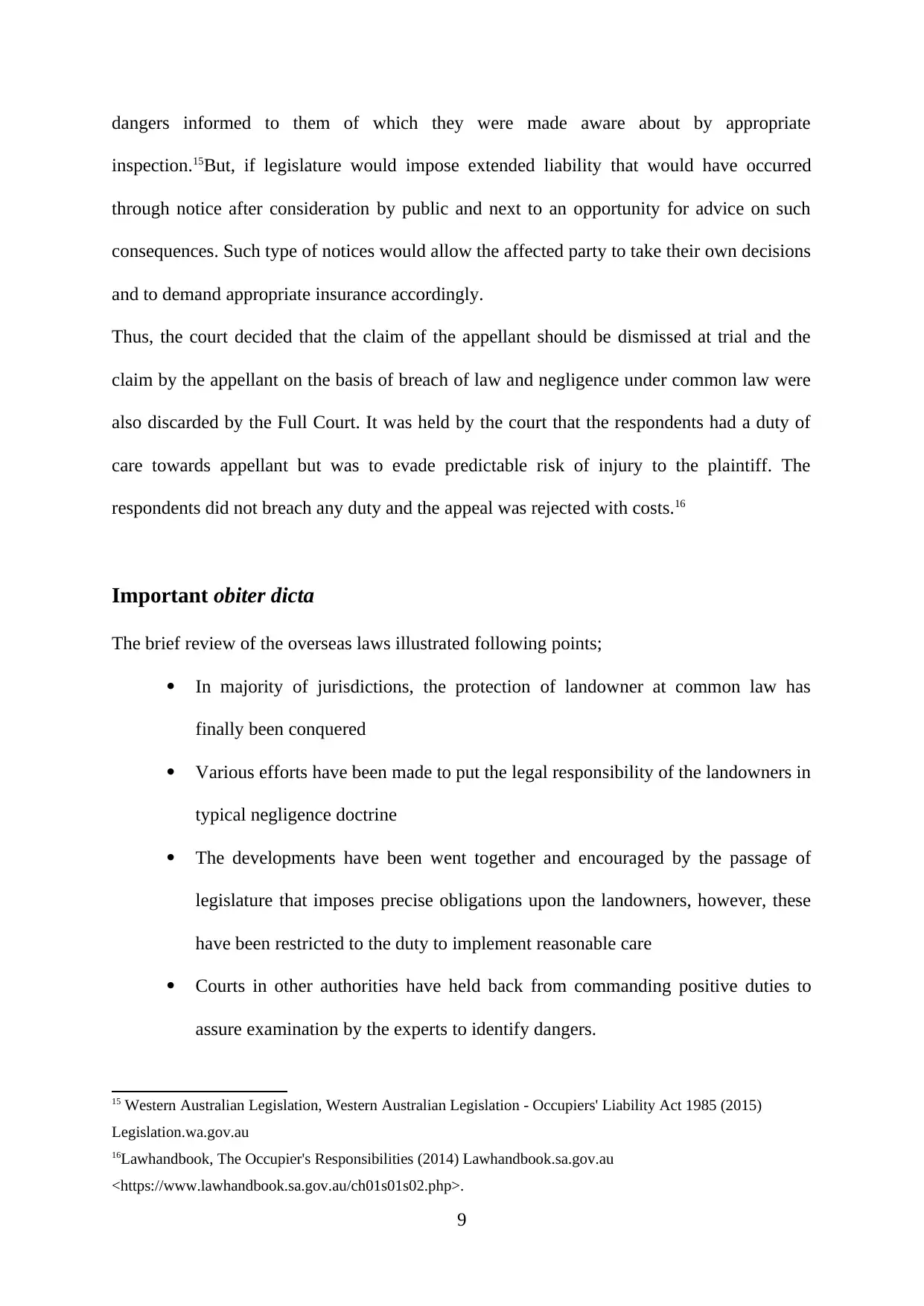
dangers informed to them of which they were made aware about by appropriate
inspection.15But, if legislature would impose extended liability that would have occurred
through notice after consideration by public and next to an opportunity for advice on such
consequences. Such type of notices would allow the affected party to take their own decisions
and to demand appropriate insurance accordingly.
Thus, the court decided that the claim of the appellant should be dismissed at trial and the
claim by the appellant on the basis of breach of law and negligence under common law were
also discarded by the Full Court. It was held by the court that the respondents had a duty of
care towards appellant but was to evade predictable risk of injury to the plaintiff. The
respondents did not breach any duty and the appeal was rejected with costs.16
Important obiter dicta
The brief review of the overseas laws illustrated following points;
In majority of jurisdictions, the protection of landowner at common law has
finally been conquered
Various efforts have been made to put the legal responsibility of the landowners in
typical negligence doctrine
The developments have been went together and encouraged by the passage of
legislature that imposes precise obligations upon the landowners, however, these
have been restricted to the duty to implement reasonable care
Courts in other authorities have held back from commanding positive duties to
assure examination by the experts to identify dangers.
15 Western Australian Legislation, Western Australian Legislation - Occupiers' Liability Act 1985 (2015)
Legislation.wa.gov.au
16Lawhandbook, The Occupier's Responsibilities (2014) Lawhandbook.sa.gov.au
<https://www.lawhandbook.sa.gov.au/ch01s01s02.php>.
9
inspection.15But, if legislature would impose extended liability that would have occurred
through notice after consideration by public and next to an opportunity for advice on such
consequences. Such type of notices would allow the affected party to take their own decisions
and to demand appropriate insurance accordingly.
Thus, the court decided that the claim of the appellant should be dismissed at trial and the
claim by the appellant on the basis of breach of law and negligence under common law were
also discarded by the Full Court. It was held by the court that the respondents had a duty of
care towards appellant but was to evade predictable risk of injury to the plaintiff. The
respondents did not breach any duty and the appeal was rejected with costs.16
Important obiter dicta
The brief review of the overseas laws illustrated following points;
In majority of jurisdictions, the protection of landowner at common law has
finally been conquered
Various efforts have been made to put the legal responsibility of the landowners in
typical negligence doctrine
The developments have been went together and encouraged by the passage of
legislature that imposes precise obligations upon the landowners, however, these
have been restricted to the duty to implement reasonable care
Courts in other authorities have held back from commanding positive duties to
assure examination by the experts to identify dangers.
15 Western Australian Legislation, Western Australian Legislation - Occupiers' Liability Act 1985 (2015)
Legislation.wa.gov.au
16Lawhandbook, The Occupier's Responsibilities (2014) Lawhandbook.sa.gov.au
<https://www.lawhandbook.sa.gov.au/ch01s01s02.php>.
9
⊘ This is a preview!⊘
Do you want full access?
Subscribe today to unlock all pages.

Trusted by 1+ million students worldwide
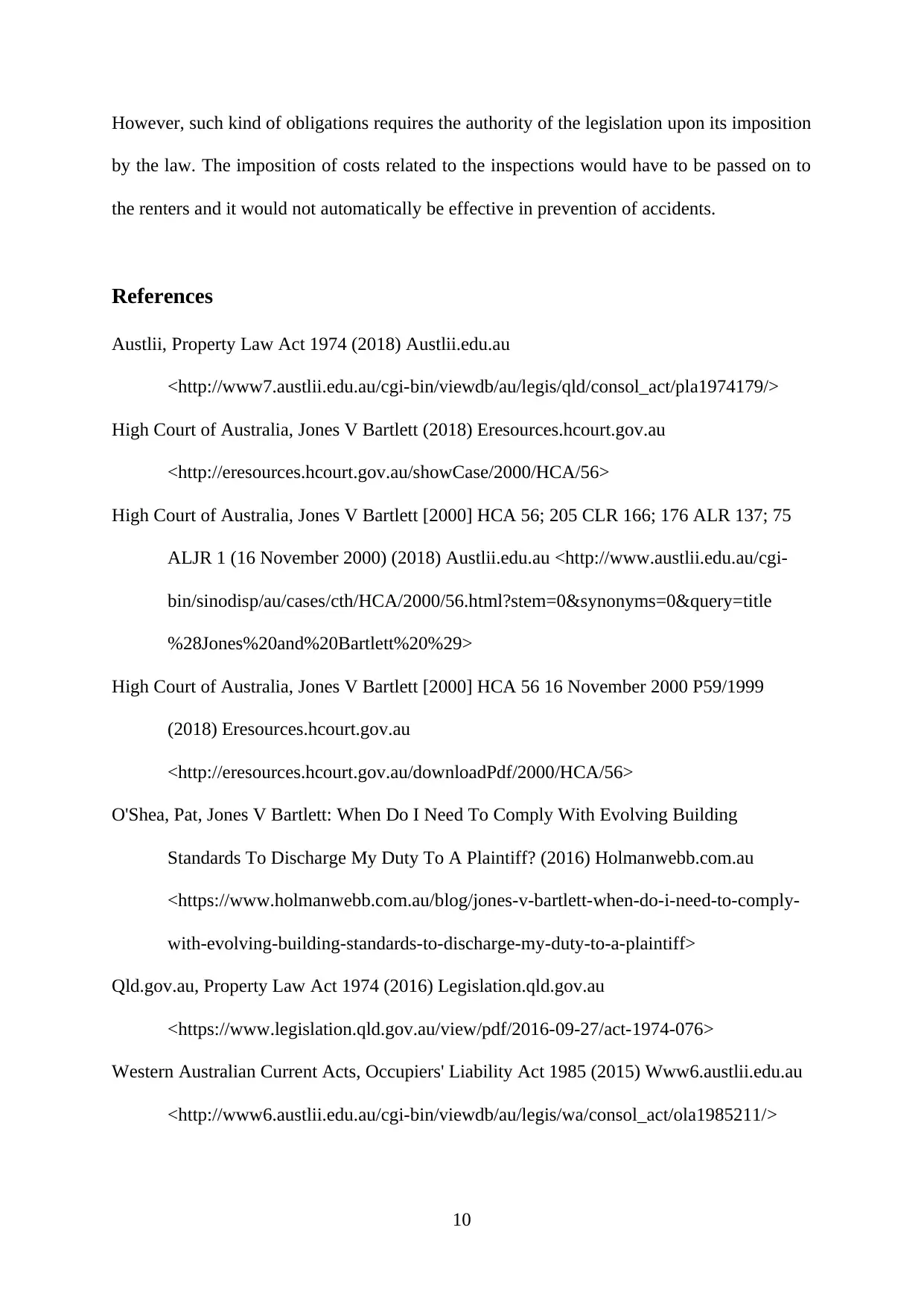
However, such kind of obligations requires the authority of the legislation upon its imposition
by the law. The imposition of costs related to the inspections would have to be passed on to
the renters and it would not automatically be effective in prevention of accidents.
References
Austlii, Property Law Act 1974 (2018) Austlii.edu.au
<http://www7.austlii.edu.au/cgi-bin/viewdb/au/legis/qld/consol_act/pla1974179/>
High Court of Australia, Jones V Bartlett (2018) Eresources.hcourt.gov.au
<http://eresources.hcourt.gov.au/showCase/2000/HCA/56>
High Court of Australia, Jones V Bartlett [2000] HCA 56; 205 CLR 166; 176 ALR 137; 75
ALJR 1 (16 November 2000) (2018) Austlii.edu.au <http://www.austlii.edu.au/cgi-
bin/sinodisp/au/cases/cth/HCA/2000/56.html?stem=0&synonyms=0&query=title
%28Jones%20and%20Bartlett%20%29>
High Court of Australia, Jones V Bartlett [2000] HCA 56 16 November 2000 P59/1999
(2018) Eresources.hcourt.gov.au
<http://eresources.hcourt.gov.au/downloadPdf/2000/HCA/56>
O'Shea, Pat, Jones V Bartlett: When Do I Need To Comply With Evolving Building
Standards To Discharge My Duty To A Plaintiff? (2016) Holmanwebb.com.au
<https://www.holmanwebb.com.au/blog/jones-v-bartlett-when-do-i-need-to-comply-
with-evolving-building-standards-to-discharge-my-duty-to-a-plaintiff>
Qld.gov.au, Property Law Act 1974 (2016) Legislation.qld.gov.au
<https://www.legislation.qld.gov.au/view/pdf/2016-09-27/act-1974-076>
Western Australian Current Acts, Occupiers' Liability Act 1985 (2015) Www6.austlii.edu.au
<http://www6.austlii.edu.au/cgi-bin/viewdb/au/legis/wa/consol_act/ola1985211/>
10
by the law. The imposition of costs related to the inspections would have to be passed on to
the renters and it would not automatically be effective in prevention of accidents.
References
Austlii, Property Law Act 1974 (2018) Austlii.edu.au
<http://www7.austlii.edu.au/cgi-bin/viewdb/au/legis/qld/consol_act/pla1974179/>
High Court of Australia, Jones V Bartlett (2018) Eresources.hcourt.gov.au
<http://eresources.hcourt.gov.au/showCase/2000/HCA/56>
High Court of Australia, Jones V Bartlett [2000] HCA 56; 205 CLR 166; 176 ALR 137; 75
ALJR 1 (16 November 2000) (2018) Austlii.edu.au <http://www.austlii.edu.au/cgi-
bin/sinodisp/au/cases/cth/HCA/2000/56.html?stem=0&synonyms=0&query=title
%28Jones%20and%20Bartlett%20%29>
High Court of Australia, Jones V Bartlett [2000] HCA 56 16 November 2000 P59/1999
(2018) Eresources.hcourt.gov.au
<http://eresources.hcourt.gov.au/downloadPdf/2000/HCA/56>
O'Shea, Pat, Jones V Bartlett: When Do I Need To Comply With Evolving Building
Standards To Discharge My Duty To A Plaintiff? (2016) Holmanwebb.com.au
<https://www.holmanwebb.com.au/blog/jones-v-bartlett-when-do-i-need-to-comply-
with-evolving-building-standards-to-discharge-my-duty-to-a-plaintiff>
Qld.gov.au, Property Law Act 1974 (2016) Legislation.qld.gov.au
<https://www.legislation.qld.gov.au/view/pdf/2016-09-27/act-1974-076>
Western Australian Current Acts, Occupiers' Liability Act 1985 (2015) Www6.austlii.edu.au
<http://www6.austlii.edu.au/cgi-bin/viewdb/au/legis/wa/consol_act/ola1985211/>
10
Paraphrase This Document
Need a fresh take? Get an instant paraphrase of this document with our AI Paraphraser
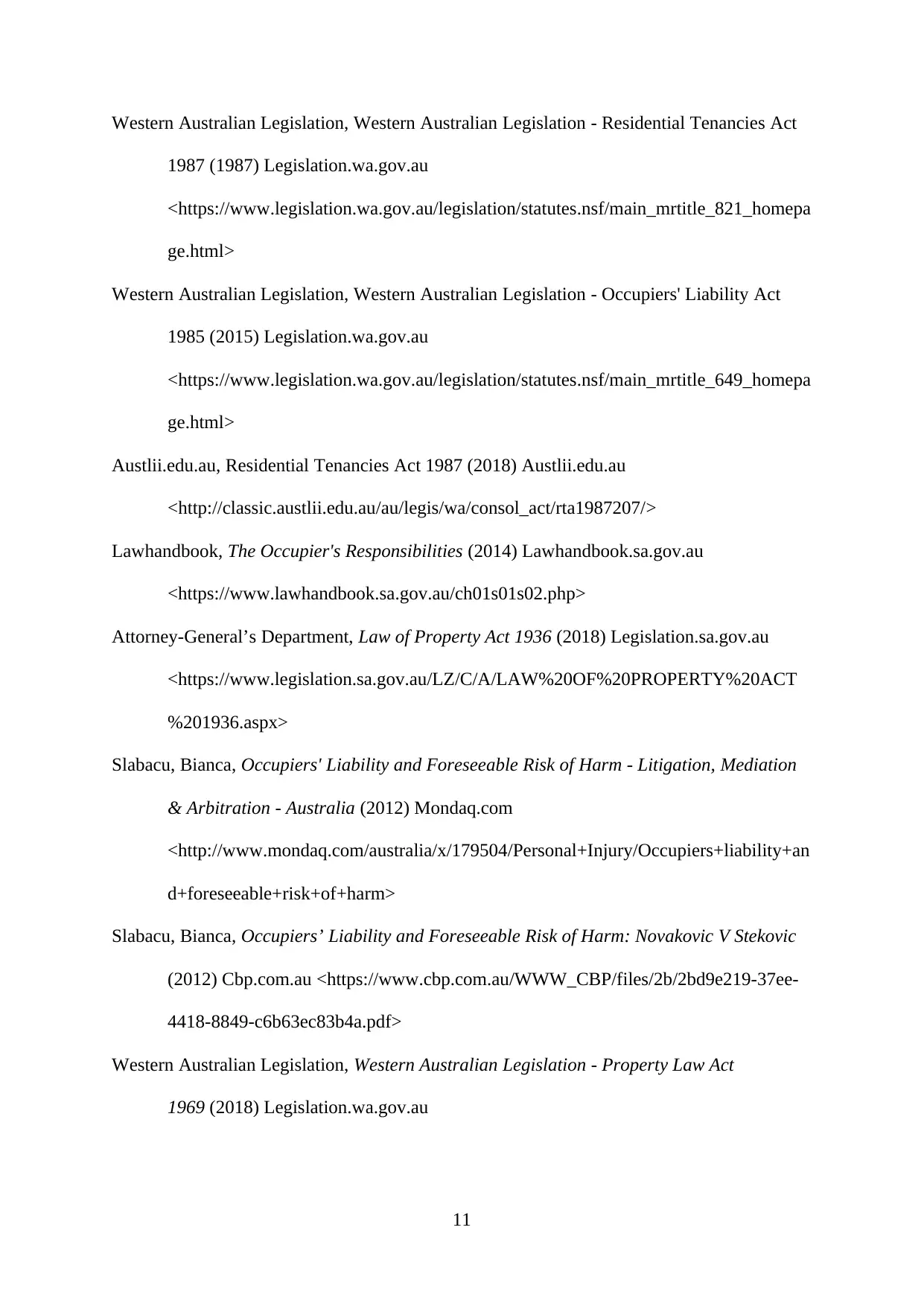
Western Australian Legislation, Western Australian Legislation - Residential Tenancies Act
1987 (1987) Legislation.wa.gov.au
<https://www.legislation.wa.gov.au/legislation/statutes.nsf/main_mrtitle_821_homepa
ge.html>
Western Australian Legislation, Western Australian Legislation - Occupiers' Liability Act
1985 (2015) Legislation.wa.gov.au
<https://www.legislation.wa.gov.au/legislation/statutes.nsf/main_mrtitle_649_homepa
ge.html>
Austlii.edu.au, Residential Tenancies Act 1987 (2018) Austlii.edu.au
<http://classic.austlii.edu.au/au/legis/wa/consol_act/rta1987207/>
Lawhandbook, The Occupier's Responsibilities (2014) Lawhandbook.sa.gov.au
<https://www.lawhandbook.sa.gov.au/ch01s01s02.php>
Attorney-General’s Department, Law of Property Act 1936 (2018) Legislation.sa.gov.au
<https://www.legislation.sa.gov.au/LZ/C/A/LAW%20OF%20PROPERTY%20ACT
%201936.aspx>
Slabacu, Bianca, Occupiers' Liability and Foreseeable Risk of Harm - Litigation, Mediation
& Arbitration - Australia (2012) Mondaq.com
<http://www.mondaq.com/australia/x/179504/Personal+Injury/Occupiers+liability+an
d+foreseeable+risk+of+harm>
Slabacu, Bianca, Occupiers’ Liability and Foreseeable Risk of Harm: Novakovic V Stekovic
(2012) Cbp.com.au <https://www.cbp.com.au/WWW_CBP/files/2b/2bd9e219-37ee-
4418-8849-c6b63ec83b4a.pdf>
Western Australian Legislation, Western Australian Legislation - Property Law Act
1969 (2018) Legislation.wa.gov.au
11
1987 (1987) Legislation.wa.gov.au
<https://www.legislation.wa.gov.au/legislation/statutes.nsf/main_mrtitle_821_homepa
ge.html>
Western Australian Legislation, Western Australian Legislation - Occupiers' Liability Act
1985 (2015) Legislation.wa.gov.au
<https://www.legislation.wa.gov.au/legislation/statutes.nsf/main_mrtitle_649_homepa
ge.html>
Austlii.edu.au, Residential Tenancies Act 1987 (2018) Austlii.edu.au
<http://classic.austlii.edu.au/au/legis/wa/consol_act/rta1987207/>
Lawhandbook, The Occupier's Responsibilities (2014) Lawhandbook.sa.gov.au
<https://www.lawhandbook.sa.gov.au/ch01s01s02.php>
Attorney-General’s Department, Law of Property Act 1936 (2018) Legislation.sa.gov.au
<https://www.legislation.sa.gov.au/LZ/C/A/LAW%20OF%20PROPERTY%20ACT
%201936.aspx>
Slabacu, Bianca, Occupiers' Liability and Foreseeable Risk of Harm - Litigation, Mediation
& Arbitration - Australia (2012) Mondaq.com
<http://www.mondaq.com/australia/x/179504/Personal+Injury/Occupiers+liability+an
d+foreseeable+risk+of+harm>
Slabacu, Bianca, Occupiers’ Liability and Foreseeable Risk of Harm: Novakovic V Stekovic
(2012) Cbp.com.au <https://www.cbp.com.au/WWW_CBP/files/2b/2bd9e219-37ee-
4418-8849-c6b63ec83b4a.pdf>
Western Australian Legislation, Western Australian Legislation - Property Law Act
1969 (2018) Legislation.wa.gov.au
11

<https://www.legislation.wa.gov.au/legislation/statutes.nsf/main_mrtitle_756_homepa
ge.html>
12
ge.html>
12
⊘ This is a preview!⊘
Do you want full access?
Subscribe today to unlock all pages.

Trusted by 1+ million students worldwide
1 out of 12
Your All-in-One AI-Powered Toolkit for Academic Success.
+13062052269
info@desklib.com
Available 24*7 on WhatsApp / Email
![[object Object]](/_next/static/media/star-bottom.7253800d.svg)
Unlock your academic potential
Copyright © 2020–2025 A2Z Services. All Rights Reserved. Developed and managed by ZUCOL.
